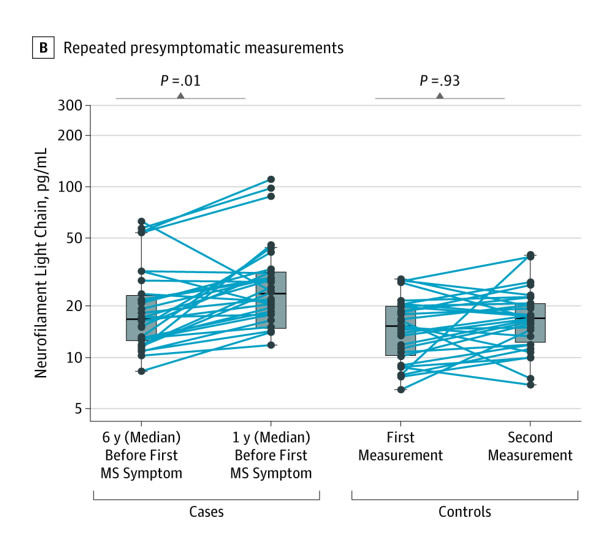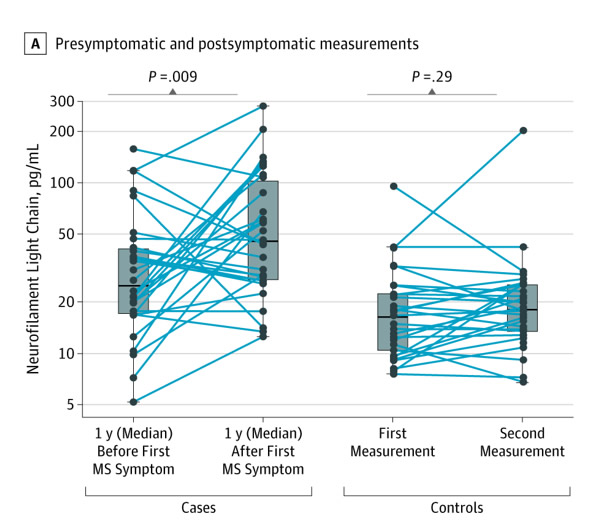Clinical Onset
Researchers reported that the difference in sNfl levels increased as time to the case clinical onset decreased (estimated coefficient for interaction with time = 0.063; P=0.008). Levels rose markedly at the point of clinical onset.
“A within-person increase in presymptomatic sNfL levels was associated with higher MS risk (rate ratio for ≥5 pg/mL increase, 7.50; 95% CI, 1.72-32.80). The clinical onset was associated with a marked increase in sNfL levels (median, 25.0; IQR, 17.1-41.3 vs 45.1; IQR, 27.0-102.7 pg/mL for presymptomatic and postonset MS samples; P = .009),” the authors wrote.

Boxplots and Within-Person Variation of Serum Neurofilament Light Chain (sNfL) Levels in Presymptomatic and Symptomatic Case Patients With Multiple Sclerosis (MS) and Matched Control IndividualsThe figure illustrates levels of sNfL in case patients with MS with 1 presymptomatic and 1 postonset measurement (A) and with repeated presymptomatic measurements (B). Log-transformed sNfL levels were compared using linear mixed-effects models adjusted for age.

The higher levels of sNfL six years prior to clinical MS onset indicated that “MS may have a prodromal phase lasting several years and that neuroaxonal damage occurs already during this phase,” the researchers concluded.
Researchers advised that this study differed from previous looks at the prodromal phase of MS, “because these have used indirect markers of this phase, which included unspecific symptoms or disturbances occurring before the clinical onset, compared with a marker of neurodegeneration.” Still, they said the findings are consistent with those of previous investigations on the prodromal phase of MS based on healthcare databases.
The article underscored the importance of better characterization of the prodromal phase of MS because “an exposure must precede the outcome to be causal, and with a prodromal phase that could last up to a decade, it may be challenging to separate risk factors from consequences of presymptomatic disease processes.”
The issue, according to researchers, is confusing the range of nonspecific symptoms that characterize the prodromal phase with risk factors. For example, heat sensitivity, a common symptom in patients with MS, may lead individuals to avoid the sun and thus have lower levels of vitamin D, the authors recounted. “If the prodromal phase of MS lasts several years and vitamin D is assessed during this period, it could lead to a spurious association between low vitamin D and higher MS risk induced by reverse causation.”
On the other hand, the authors pointed out that more knowledge about the prodromal phase also will point to a period of time when environmental risk factors might be more likely to affect future MS risk.
While early identification of servicemembers with MS could help improve treatment and understanding of the disease, using sNfl has some significant limitations, Bjornevik emphasized.
“Neurofilament light chain is not a specific biomarker for MS and can be elevated in other diseases and conditions,” he added. “Thus, the biomarker alone cannot be used to determine whether someone has MS or whether someone can stay on active duty.”
Bjornevik also noted that the study group was small, at only 60 MS patients, and said larger studies are planned to confirm the findings.
- Bjornevik K, Munger KL, Cortese M, et al. Serum Neurofilament Light Chain Levels in Patients With Presymptomatic Multiple Sclerosis [published online ahead of print, 2019 Sep 13]. JAMA Neurol. 2019;77(1):58-64. doi:10.1001/jamaneurol.2019.3238

